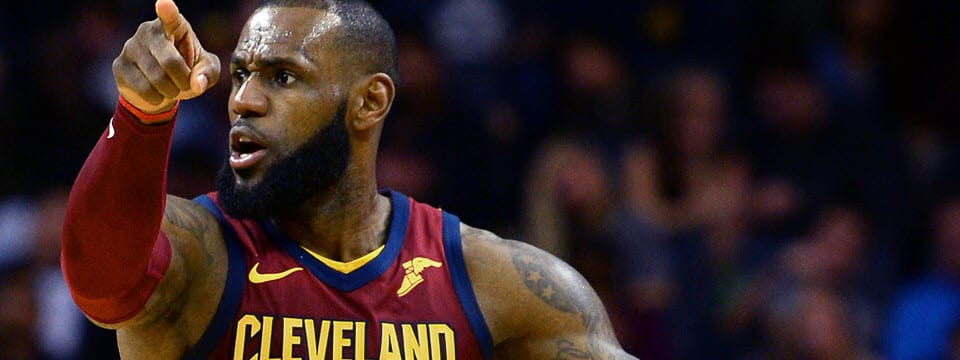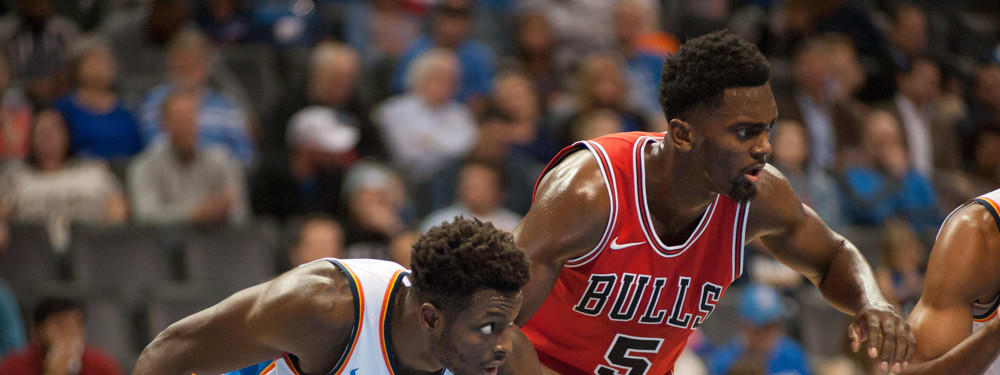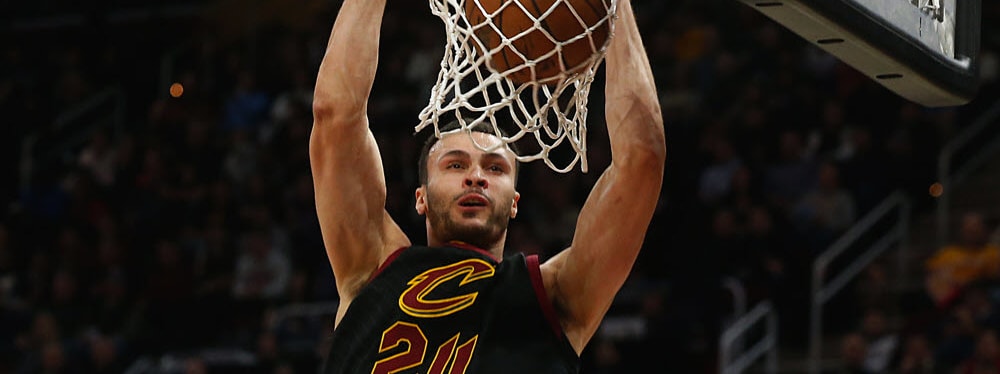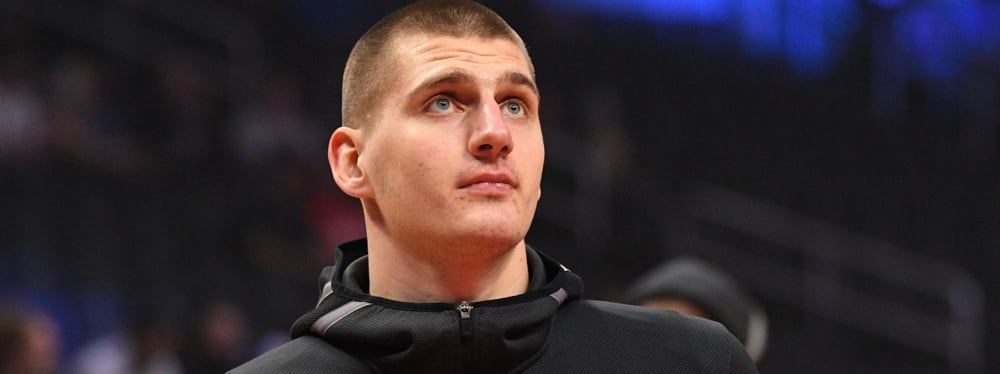Recent RotoWire Articles Featuring Channing Frye
See More
Frye played in just nine games with the Lakers last year before being dealt to the Cavaliers at the trade deadline. The 35-year-old veteran went on to become a minor contributor off the bench for Cleveland and averaged 4.8 points and 2.5 rebounds across 12.4 minutes. Despite being a career 38.7 percent shooter from deep, Frye also finished just 33.3 percent from deep in 44 games. That said, his contributions as a veteran leader and extension of the coaching staff earned him a one-year contract extension this offseason. Look for Frye to provide depth at both the power forward and center spot, but considering his age, he'll be nothing more than a mentor once again. Go ahead and avoid him in the bulk of Fantasy leagues unless a handful of injuries were to occur during the season.
Frye had a strong first full season in Cleveland, playing in 74 games and averaging 18.9 minutes per contest. That translated to 9.1 points and 3.9 rebounds, while helping to stretch the floor as a deadly three-point shooting big off the bench. He made 1.9 three-pointers per game and shot an impressive 40.9 percent from deep, marking his highest percentage from deep since the 2009-10 season. Heading into the upcoming season, Frye returns to Cleveland in a similar role. He'll continue add a floor-spacing scoring threat off the bench in the second unit, spending most of his time at center behind Tristan Thompson and Kevin Love. The addition of Jae Crowder could cost Frye some minutes at the power forward spot, though it likely won't be enough to see a serious decrease in minutes. Frye is still extremely value as a floor-spacer off the bench, meaning he should see a similar role going into his 12th NBA season. That said, he likely doesn't see enough minutes to be a relevant Fantasy option in the majority of Fantasy formats.
Frye was a revelation for the Cavaliers after coming over from the Magic at the trade deadline last season. While his averages of 7.5 points and 3.6 rebounds per game and a 37.7 mark from three-point range in 26 regular season contests don't jump off the page, Frye provided the eventual champs with another strong-shooting big man to space the floor and help spell Kevin Love. Frye's true value was demonstrated in the playoffs, when he knocked down nearly 57 percent of his three-point attempts and was a key contributor to Cleveland winning their first 10 postseason games. While his role diminished against Golden State in the NBA Finals, Frye remained an integral bench weapon lauded as much for his positive locker room presence as his three-point stroke. Frye returns to Cleveland this season on the third year of the four-year, $32 million deal he inked with Orlando prior to the 2014-15 campaign. The 33-year-old figures to hold a similar role to last season, though he's unlikely to see significant minutes on a consistent enough basis to warrant fantasy value in most leagues.
Frye failed to live up to the four-year, $32 million deal he signed last offseason. At the start of training camp, he suffered a sprained left MCL and ultimately returned after missing just the first game of the regular season. Under interim head coach James Borrego, Frye ceded his starting spot and playing time in the name of developing the younger players in a lost season. He finished the year averaging 7.3 points, 3.9 rebounds, 1.3 assists, and 1.8 three-pointers in 25 minutes per game. Frye shot a career-low 39 percent from the field, a team-high 39 percent from distance, and a team-high 89 percent from the free-throw line. Even though he led the Magic in free-throw percentage, his 35 attempts were the second-fewest behind the Jazz's Dante Exum among players with at least 1,300 minutes played. For the second straight season, Frye hit the second most three-pointers among power forwards with 136 makes. With new coach Scott Skiles on board, Frye could endure additional marginalization as he recorded a team-worst 107.4 defensive rating last season, the antithesis of a Skiles coached team. When paired with Nikola Vucevic, that number climbed to 110.5, lending credence to the theory that Aaron Gordon could overtake Frye in the starting lineup by opening night.
Channing Frye joins his fourth team in nine NBA seasons. After sitting out the 2012-13 season due to an enlarged heart, Frye returned last season to average 11.1 points, 5.1 rebounds, 1.2 assists, 0.7 steals, and 0.8 blocks in 28 minutes per game through 82 games. The 31-year-old shot 43 percent from the field on 9.5 attempts per game and 82 percent from the line on 1.2 attempts. The duo of Frye and Goran Dragic led the NBA in points per pick-and-roll possessions last season (1.3), and the Phoenix Suns' offense was eight points better per 100 possessions with Frye on the court. He finished second to Kevin Love in total power forward three-pointers (160) and ninth among all forwards, finishing 30 behind Love and 29 ahead of the next nominal power forward (Dirk Nowitzki), finishing with 2.0 three-pointers per game. Frye's duty as a pick-and-pop maestro pulls him away from the basket, contributing to his porous rebounding rate. Though he stands at 6-11 and claims center eligibility in several fantasy formats, he can be thought of like a small forward in fantasy based on his statistical production.
One of the elder statesmen remaining on the roster, Frye is the oldest Suns' player at 30. He is also far and away their best shooter. Recently cleared to resume workouts after missing a year with an enlarged heart, the hope is for him to provide double-figure scoring and a couple three-pointers per game, while teaching the Morris twins to do the same.
Frye has had a resurgence as a fantasy player as a big who can shoot while not hurting you too badly from a rebounding and blocked shot perspective. The question is how much was his value dependent on Steve Nash providing him with open looks on offense, and will Dragic be able to get him the same looks? Either way, his value will take a hit as Scola will likely take his starting role.
After appearing to be a bust in the NBA, Frye has rediscovered himself as a stretch four. There are not many seven-foot players who can hit the three, and as such, Frye poses a matchup problem for most NBA bigs. His three-point ability makes him very intriguing from a fantasy perspective, as he can provide rebounds, blocks, points and over two three-pointers per game.
Frye went from an afterthought to a viable option in fantasy leagues last year after joining Phoenix – a move that changed his role on offense by putting him away from the basket. While Frye attempted a total of 70 three-pointers over his first four years in the NBA, he threw up 392 shots from downtown last season alone. As a result, he averaged 2.1 3pt, and his 0.8 spg and 0.9 bpg were helpful as well. Still, 11.2 ppg and 5.2 rpg aren't too impressive, and you'll be at a major disadvantage on the boards if you make Frye your No. 1 center, though he'll be asked to contribute more on the glass with Amar'e Stoudemire gone. Still, the Suns also added Hakeem Warrick via free agency, Robin Lopez should improve and it's possible 2009 first round pick Earl Clark could eventually earn frontcourt minutes as well. Frye was a nice surprise last season, but he's disappointed far more than he's lived up to expectations throughout his career.
The seven-footer has seen his production drop for four straight seasons, and he was never able to carve out a regular role for himself in Portland. Coming to Phoenix may revive his career, however, as unlike many other teams the Suns may be more forgiving of his lack of toughness and rebounding if his outside shooting can provide matchup problems on offense. With Robin Lopez not exactly a lock for big minutes at center there's an opportunity for Frye to win the starting job outright and return to the level of production he enjoyed as a rookie.
Frye looked promising as a rookie while playing for the Knicks during the 2005-06 season, but he’s declined ever since. In fact, his ppg, rpg and bpg have all dropped in each consecutive season. Last year playing for Portland, he was almost an afterthought, averaging a career-low 17:11 mpg. However, he did reveal potential with a solid final month to the season, averaging 12.4 ppg, 8.4 rpg and 1.0 spg on 56.6-percent shooting during April. Still, with Greg Oden joining an already deep frontcourt that also includes LaMarcus Aldridge, Frye’s minutes don’t figure to increase anytime soon.
Frye had a great rookie year but tailed off in his sophomore year as he split time with David Lee and Renaldo Balkman. This year seemed to be the same story, but now that Oden is out for the year, he has a legitimate shot at starting at center or being the first guy off the bench to play the four or five. He is a decent rebounder with a consistent 15-foot shot. If he finds himself fully entrenched in the rotation, 11 points, six rebounds, and one block is reasonable.
Frye was in the midst of a strong rookie season before it was cut short due to a knee injury. His averages of 12.3 ppg and 5.8 rpg were good enough to get him selected to the NBA all-rookie team. Frye is a long and relatively thin 6-11, and he spends as much time in the mid-range as he does under the rim. The big question for his sophomore campaign is whether he’ll be in the starting line-up and getting consistent minutes under new coach Isiah Thomas after the roller-coaster minutes he got under Larry Brown last season. If so, Frye definitely has the ability to improve on those offensive/rebounding numbers while contributing in the shooting percentages as well (48% FG and 83% FT as a rookie), though he will likely never do much in the defensive (.7 bpg, .5 spg) or assist (.8 apg) categories.
Frye was considered one of the more polished and NBA-ready big men in the draft this year, but his performance in the summer leagues (matched up with such luminaries as Indiana’s David Harrison) left the impression that he’ll have trouble adjusting to the speed and power of the NBA game. Going into this season, the best-case scenario for Frye is 15-20 minutes a night as Jerome James' backup.
Frye has good athleticism for his size and is potentially the best shot-blocking talent in the draft. He possesses great shot selection and, as a result, shoots a very high percentage from the field. Frye can be dominant in the paint at times, but is more of a complementary player than a star. The biggest knock on Frye is that he doesn’t rebound very well for his size and doesn’t have great upside. Frye projects to be taken in the lottery.












